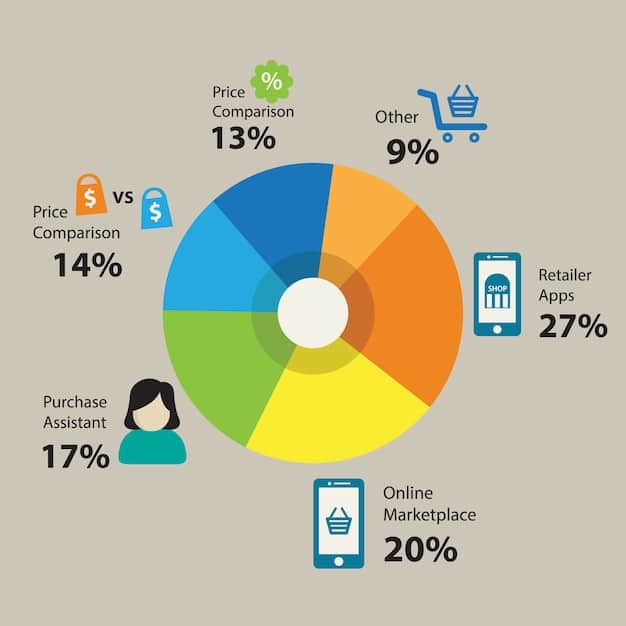Cut Spending: A 30-Day Guide to Eliminating Unnecessary Expenses

Cut Your Spending: Identify and Eliminate Unnecessary Expenses in 30 Days by meticulously tracking your spending, identifying areas for reduction, setting realistic financial goals, and making gradual adjustments to your lifestyle, all while focusing on long-term financial health.
Are you tired of feeling like your money is slipping through your fingers? Do you want to take control of your finances and achieve your financial goals faster? This article provides a comprehensive 30-day plan to cut your spending: identify and eliminate unnecessary expenses in 30 days, paving the way for a more secure and fulfilling financial future.
Assess Your Current Financial Situation
Before you can effectively cut your spending, it’s crucial to understand where your money is going. This involves taking a detailed look at your income, expenses, debts, and assets to get a clear picture of your financial health.
Track your income and expenses
Start by tracking every dollar you earn and spend. This can be done using a budgeting app, a spreadsheet, or even a simple notebook. The key is to be consistent and detailed. Include everything, from your morning coffee to your monthly rent or mortgage payment.
Categorize your spending habits
Once you’ve tracked your spending for a week or two, categorize your expenses. Common categories include housing, transportation, food, entertainment, utilities, and debt payments. Identifying which categories consume the largest portion of your income is a critical step in taking control of your spendings.

- Use budgeting tools: Explore budgeting apps like Mint, YNAB (You Need a Budget), or Personal Capital. These tools automatically track your spending and categorize it for you.
- Review bank and credit card statements: Go through your bank and credit card statements to identify any recurring expenses or subscriptions you may have forgotten about.
- Be honest with yourself: Don’t underestimate or omit any expenses, even if they seem small. Every dollar counts when aiming to cut your spending.
By thoroughly assessing your financial situation, you’ll gain a solid understanding of where your money is going, which will provide a strong foundation for developing a realistic and effective plan to cut your spending.
Set Realistic Financial Goals
Having clear and achievable financial goals is essential for motivating yourself to cut spending. These goals should be specific, measurable, attainable, relevant, and time-bound (SMART).
Define your short-term and long-term objectives
Begin by defining what you want to achieve financially in the short term (e.g., paying off a credit card balance, saving for a down payment) and the long term (e.g., buying a house, retirement planning). These goals will serve as your compass as you navigate the process of reducing expenses.
Prioritize your financial goals
Not all financial goals are created equal. Prioritize the ones that are most important to you and align with your values. Doing so is vital for keeping the process in perspective and staying clear on ultimate goals.
- Focus on debt reduction: If you have high-interest debt, such as credit card debt, make it a priority to pay it off as quickly as possible. This will improve your cash flow and save you money on interest payments.
- Establish an emergency fund: Aim to save at least three to six months’ worth of living expenses in an emergency fund. This will provide a financial cushion in case of unexpected events, such as job loss or medical emergency.
- Invest for the future: Once you’ve addressed your immediate financial needs, start investing for the future, such as retirement or your children’s education.
Setting realistic financial goals provides direction and motivation for managing your spending. Having a strong understanding of your current financial situation and identifying specific goals is essential to creating a plan that meets your individual needs and circumstances.
Identify Areas for Spending Reduction
Now that you’ve assessed your financial situation and set your goals, it’s time to identify areas where you can reduce your spending. This involves a careful review of your expenses and a willingness to make some sacrifices.
Evaluate your fixed expenses
Fixed expenses are those that remain relatively constant from month to month, such as rent or mortgage payments, insurance premiums, and loan payments. While these expenses may be difficult to reduce, they represent a significant portion of your budget and are prime targets for review. Investigate if it is possible to refinance your mortgage or consolidate debt to reduce monthly payments.
Analyze your variable expenses
Variable expenses are those that fluctuate from month to month, such as food, entertainment, and clothing. These expenses offer the most flexibility to reduce spending. Look at areas where you can cut back, such as dining out less often, buying generic brands, or canceling subscriptions you don’t use.

- Cut cable and streaming services: Consider ditching cable and subscribing to streaming services that offer more content at a lower cost.
- Reduce transportation costs: Walk, bike, or take public transportation whenever possible. If you drive, consider carpooling or finding cheaper parking options.
- Shop around for insurance: Compare rates from different insurance companies to ensure you’re getting the best deal on your car, home, and life insurance policies.
Identifying areas for spending reduction can be done by scrutinizing different areas in your life where it is possible to cut corners on non-essential purchases. Cutting back in these areas will help you reach your financial goals faster.
Implement Practical Spending Cuts
Identifying areas for spending reduction is only half the battle. You also need to implement practical strategies to reduce your expenses on a daily basis. This requires discipline, creativity, and a willingness to change your habits.
Cook at home more often
Eating out can be a major budget-buster. Resolve to cook at home more often, even if it means spending a little more time in the kitchen. You’ll save money and eat healthier, too.
Find free or low-cost entertainment options
There are plenty of ways to have fun without spending a lot of money. Take advantage of free events in your community, such as concerts, festivals, and museum days. Explore local parks and hiking trails, or host a potluck with friends.
Practice mindful spending
Be aware of your spending triggers and avoid impulse purchases. Before making a purchase, ask yourself if you really need it or if it’s just something you want. Wait at least 24 hours before buying non-essential items.
- Use coupons and discounts: Look for coupons and discounts before you shop, both online and in stores.
- Buy in bulk: Stock up on non-perishable items when they’re on sale.
- Negotiate bills: Don’t be afraid to negotiate your bills with service providers, such as your cable company or cell phone provider.
Implementing practical spending cuts will help you start to see the direct benefits of your efforts. By consistently applying these strategies, you’ll be well on your way to achieving your financial goals.
Stay Motivated and Track Your Progress
Cutting spending can be challenging, especially in the beginning. It’s important to stay motivated and track your progress to see how far you’ve come. Celebrating milestones and rewarding yourself for your efforts will help you stay on track.
Monitor your spending regularly
Continue to track your spending, even after you’ve implemented your spending cuts. This will help you identify any areas where you may be slipping back into old habits. Review your budget regularly and make adjustments as needed.
Celebrate your successes
Acknowledge and celebrate your achievements, no matter how small. Did you successfully cook at home for an entire week? Did you pay off a credit card balance? Reward yourself with something that doesn’t break the bank, such as a movie night or a relaxing bath.
Seek support from others
Talk to friends, family members, or a financial advisor about your goals and challenges. Having a support system can help you stay motivated and accountable. Remember that a challenge is easier to tackle when there are people helping you.
- Join a financial community: Connect with like-minded individuals online or in person to share tips, ideas, and encouragement.
- Read personal finance blogs and books: Educate yourself about personal finance and learn from the experiences of others.
- Remember your “why”: Keep your financial goals in mind and remind yourself why you’re making these changes.
Staying motivated and tracking your progress are essential for long-term success. By celebrating your wins, seeking support, and keeping your goals in sight, you can overcome challenges and create lasting financial freedom.
Adjust Your Lifestyle for Long-Term Financial Health
Cutting spending is not just a short-term fix. It’s a lifestyle change that requires ongoing commitment and adjustments. By incorporating these strategies into your daily routine, you can gain control of your finances and create a more secure future.
Embrace minimalism
Consider adopting a minimalist lifestyle, which involves decluttering your home and focusing on experiences rather than material possessions. This can help you reduce your consumption and save money in the process.
Automate your savings
Set up automatic transfers from your checking account to your savings account each month. This ensures that you’re consistently saving money without having to think about it. You can also automate your investment contributions.
Review your progress annually
Take time each year to review your financial progress and make adjustments to your budget and financial goals as needed. Life changes, such as a new job or a growing family, may require you to re-evaluate your spending habits.
- Invest in yourself: Continue to learn and grow your skills, as this can lead to higher earning potential.
- Plan for retirement: Make sure you’re contributing enough to your retirement accounts to secure your future.
- Give back: Consider donating to charities or causes that are important to you. Giving back can bring a sense of purpose and fulfillment to your life.
Adjusting your lifestyle for long-term financial health requires a commitment to continuous learning and improvement. By embracing minimalism, automating savings, and regularly reviewing your progress, you can maintain control of your finances and create a more secure future.
| Key Point | Brief Description |
|---|---|
| 📊 Track Spending | Monitor income and expenses to understand where money goes. |
| 🎯 Set Goals | Define realistic financial goals, both short-term and long-term. |
| ✂️ Reduce Expenses | Identify and cut unnecessary expenses in variable spending. |
| 🌱 Adjust Lifestyle | Incorporate long-term financial health habits. |
Frequently Asked Questions
▼
The first step is to assess your financial situation by tracking your income and expenses. This helps you understand where your money is going and identify areas for reduction.
▼
Stay motivated by setting realistic financial goals, celebrating your successes, tracking your progress regularly, and seeking support from friends, family, or financial communities.
▼
Common areas to cut spending include dining out, entertainment, subscriptions, transportation costs, and variable expenses like clothing or non-essential household items.
▼
You should review your budget regularly, ideally monthly, to ensure you are still on track with your financial goals and to make any necessary adjustments. Annual reviews are also important.
▼
Yes, it is possible. Prioritize what is most important to you and find creative ways to reduce spending without fully depriving yourself. Focus on mindful spending habits and finding free or low-cost alternatives.
Conclusion
Embarking on a journey to cut your spending: identify and eliminate unnecessary expenses in 30 days can be a transformative experience, empowering you to take control of your finances and move closer to your dreams by being resourceful, patient, and finding new ways to make your money work for you.





